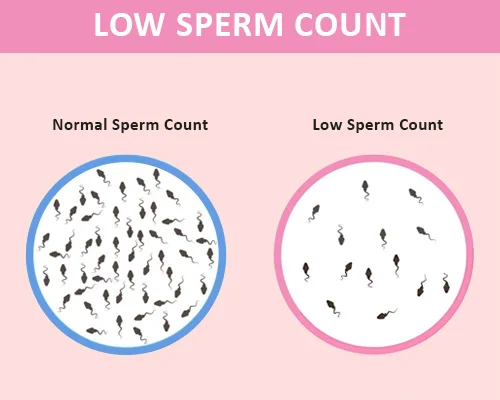
Low sperm count can also be referred to as “Oligospermia”.
Low sperm count means that the fluid (semen) you ejaculate during an orgasm contains fewer sperm than normal.
Sperm count is considered lower than normal if you have fewer than 15 million sperm per milliliter of semen.
When your sperm count is low, there is less chance that one of them will fertilize the egg of your partner, creating a pregnancy. Even so, many men who have low sperm counts are still able to father children.
You may not know you have a low sperm count (also called oligospermia) until you’re trying to have a baby and aren’t succeeding.

Inability to conceive a baby with a partner after one year of unprotected sexual intercourse.
In some men, an underlying problem such as an inherited chromosomal abnormality, a hormonal imbalance, dilated testicular veins or a condition that blocks the passage of sperm may cause signs and symptoms.
Low sperm count symptoms might include:
Problems with sexual function — for example, low sex drive or difficulty maintaining an erection (erectile dysfunction)
Pain, swelling or a lump in the testicle area
Decreased facial or body hair or other signs of a chromosome or hormone abnormality.

Surgeries, Infections, Current and Past Health Issues.
Genetic or Chronic Disease.
Lifesaving cancer treatment either surgery, chemotherapy, or radiation therapy can destroy sperm cells, and greatly decrease a man’s sperm count.
Structural Problems with the Penis or Testicles
Structural problems with the penis that can cause a man’s sperm count to plummet include Peyronie’s disease (in which plaque and/or scar tissue builds up in the penis), as well as problems with inflammation and scar tissue that can interfere with the normal ejaculatory process.
Other potentially important structural issues include undescended testicles, sperm duct problems, and blockages in the tubes that transport sperm (vas deferens).
Previous vasectomy
Hormonal imbalance
Environmental and Lifestyle Factors: Alcohol abuse
Anabolic steroids
Cigarette smoking
Exposure to toxic chemicals, heavy metals, pesticides, paint and solvents
Illegal drugs, including cocaine and marijuana
Obesity

A low sperm count is diagnosed as part of a semen analysis test. Sperm count is generally determined by examining semen under a microscope to see how many sperm appear within squares on a grid pattern. In some cases, a computer might be used to measure sperm count.
Semen samples can be obtained in a couple of different ways. You can provide a sample by masturbating and ejaculating into a special container at the doctor’s office. Because of religious or cultural beliefs, some men prefer an alternative method of semen collection. In such cases, semen can be collected by using a special condom during intercourse.
New sperm are produced continually in the testicles and take about 42 to 76 days to mature. So, a current semen analysis reflects your environment over the past three months. Any positive changes you’ve made won’t show up for several months.
To ensure accuracy in a collection, your doctor will:
Ask you to make sure all of your semen makes it into the collection cup or collection condom when you ejaculate
Have you abstain from ejaculating for two to seven days before collecting a sample
Collect a second sample at least two weeks after the first
Have you avoid the use of lubricants because these products can affect sperm motility
Normal sperm densities range from 15 million to greater than 200 million sperm per milliliter of semen. You are considered to have a low sperm count if you have fewer than 15 million sperm per milliliter or less than 39 million sperm total per ejaculate.
Your chance of getting your partner pregnant decreases with decreasing sperm counts. Some men have no sperm in their semen at all. This is known as azoospermia.

Forever Champion Health Center has an organic treatment therapy designed to support healthy sperm development and increases a man’s chances of fathering a child and supports men’s overall reproductive health
It also contain antioxidants, zinc, B12, folic acid and other powerful nutrients.
These are designed to address the issue of low sperm count and improve male reproductive health. Here are some common goals and functions of low sperm count products:
We are ready to champion the goal of restoring your fertility.
Book an appointment to discuss your fertility issues today.
Call or send us a WhatsApp message to 0536828580.
Forever Champion Health Centre (FCHC) offers natural solutions to Prevent common medical conditions and initiate pure natural treatment for chronic illness.